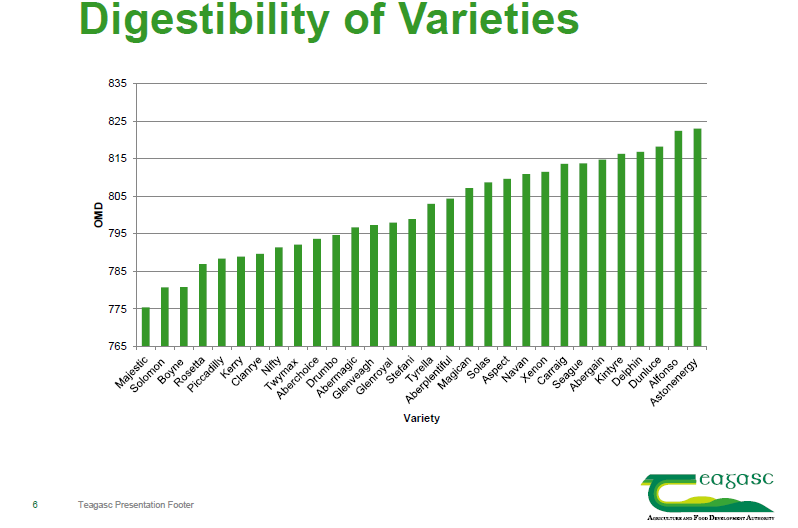Recent results from grazing variety trials at Teagasc Moorepark show that AstonEnergy, a late tetraploid, is the highest digestible variety under grazed management.
What really sets AstonEnergy apart in the results is that it is grazed out better than any other variety available. AstonEnergy should be a component in any grazing mixture sown this year.
Grazing trial
In 2016, Teagasc Moorepark sowed all the varieties from the 2016 recommended list and grazed them during 2017 and 2018.
Varieties were yielded, measured for digestibility, with pre and post grazing sward height also recorded. The purpose of the trial was to add additional information to what is presented in the Pasture Profit Index (PPI).
All figures in the PPI are derived from cutting trials conducted by the Department of Agriculture across five Irish sites, so no animal preference is included in the official evaluation. This is obviously a vast contrast to how most of the grass is utilised in Ireland.
Post-grazing sward height
During the trial, each grazing cow was allowed to select freely between different variety plots. Varieties that had a natural ability to be grazed lower showed lower post-grazing sward height results.
We see most of the tetraploids were grazed better than diploids. Tetraploids have an advantage due to their erect growth habit and higher digestibility.
AstonEnergy was the best grazed. This means that the AstonEnergy sward can regrow from a clean base each time, with no stem or dead material being carried over to the next grazing.
Each time an animal puts grass in its mouth it has the potential to make money. Grass that must be topped is only a cost to the farm and uses valuable time.
Patrick Cashman of Goldcrop said: “No variety has a more beneficial impact on how clean a sward is grazed than AstonEnergy. Cows love grazing swards with AstonEnergy clean.
“What trial work is starting to show now is that AstonEnergy will improve the grazout of the overall mixture. This is consistent with the feedback we get back from farmers across the country.”
Digestibility
Digestibility results show some reranking in performance from the PPI. This is because stem and dead material can be carried over from previous grazings, as poor grazing is extremely indigestible.
This kind of carry over would not show up in cutting trials. AstonEnergy was found to be the variety with the best sward digestibility under grazing management.
Digestibility of a sward and the ease of intake while reaching a correct residual are the key drivers of animal performance.
It is thus reasonable to assume that under grazing management, AstonEnergy will have a very beneficial effect on animal performance, even in a mixture.
Should a mixture be all tetraploid?
If we followed grazing efficiency completely you would likely end up with a mixture that is all tetraploid.
While some farmers are experimenting with promising results on these swards, the industry norm is to include approximately half diploid in a mixture.
There are solid reasons for this. All tetraploid swards are more open, tending to be more prone to weed ingress, poor persistence and poaching on certain farms.
Oakpark and AstonKing are two new late diploids added to the PPI this year. Oakpark is a new Teagasc-bred late diploid that was developed at the Carlow breeding station.
It has excellent seasonal growth characteristics, good quality for a late diploid and excellent silage yield should the sward be required for a cut of silage. Oakpark also has very good ground cover which can be desirable in certain regions.
Further information
For more information click here



